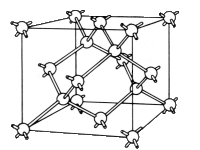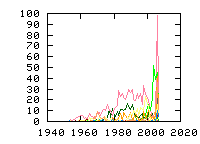« Previous
1
Next »
(18 hits, 1/1)
Showing
10, 25, 50, 100, 500, 1000, all papers per page.
Sort by:
last publication date,
older publication date,
last update date.
- 1. Appl. Phys. Lett. 89, 142914 (2006) , “Defect passivation in HfO2 gate oxide by fluorine”, K. Tse and J. RobertsonThe authors have calculated that fluorine substituting for oxygen gives no gap states in HfO2. This accounts for the good passivation of oxygen vacancies by F seen experimentally. Bonding arguments are used to account for why F may be the most effective passivant in ionic oxides such as... (Read more)
- 2. Appl. Phys. Lett. 89, 082908 (2006) , “Negative oxygen vacancies in HfO2 as charge traps in high-k stacks”, J. L. Gavartin, D. Muñoz Ramo, A. L. Shluger, G. Bersuker, and B. H. LeeThe optical excitation and thermal ionization energies of oxygen vacancies in m-HfO2 are calculated using a non-local density functional theory with atomic basis sets and periodic supercell. The thermal ionization energies of negatively charged V– and... (Read more)
- 3. Appl. Phys. Lett. 88, 201918 (2006) , “Diffusion of zinc vacancies and interstitials in zinc oxide”, Paul Erhart and Karsten AlbeThe self-diffusion coefficient of zinc in ZnO is derived as a function of the chemical potential and Fermi level from first-principles calculations. Density functional calculations in combination with the climbing image-nudged elastic band method are used in order to determine migration barriers for... (Read more)
- 4. Appl. Phys. Lett. 88, 162107 (2006) , “Physical origin of threshold voltage problems in polycrystalline silicon/HfO2 gate stacks”, Dae Yeon Kim, Joongoo Kang, and K. J. ChangBased on theoretical calculations, we find that at p+ polycrystalline silicon (poly-Si)/HfO2 gates, Si interstitials are easily migrated from the electrode, forming Hf–Si bonds with a charge transfer to the electrode, and the resulting interface dipole raises the Fermi level... (Read more)
- 5. J. Appl. Phys. 99, 073709 (2006) , “Optical and electron paramagnetic resonance spectroscopies of diffusion-doped Co2+:ZnSe”, Ming Luo, N. Y. Garces, N. C. Giles, Utpal N. Roy, Yunlong Cui, and Arnold BurgerThe efficacy of diffusing cobalt into window-grade polycrystalline ZnSe during high-temperature anneals has been studied. Absorption, photoluminescence (PL), time-resolved PL, and electron paramagnetic resonance (EPR) were used to characterize samples with cobalt concentrations ranging from... (Read more)
- 6. J. Appl. Phys. 99, 044105 (2006) , “Passivation of oxygen vacancy states in HfO2 by nitrogen”, K. Xiong, J. Robertson, and S. J. ClarkNitrogen is known to reduce leakage currents and charge trapping in high-dielectric-constant gate oxides such as HfO2. We show that this occurs because nitrogen, substituting for oxygen atoms next to oxygen vacancy sites, repels the occupied gap states due to the neutral and positively... (Read more)
- 7. Phys. Rev. B 74, 235209 (2006) , “Comparison of two methods for circumventing the Coulomb divergence in supercell calculations for charged point defects”, A. F. Wright and N. A. ModineDensity-functional-theory calculations were performed for the unrelaxed +2 Si vacancy and +2 self-interstitial utilizing periodic boundary conditions and two different methods—the uniform background charge method and the local moment counter charge method—for circumventing the divergence... (Read more)
- 8. Phys. Rev. B 74, 165202 (2006) , “Structural and electronic properties of Fe3+ and Fe2+ centers in GaN from optical and EPR experiments”, E. Malguth, A. Hoffmann, W. Gehlhoff, O. Gelhausen, M. R. Phillips, and X. XuThis work provides a consistent picture of the structural, optical, and electronic properties of Fe-doped GaN. A set of high-quality GaN crystals doped with Fe at concentrations ranging from 5×1017 cm–3 to 2×1020 cm–3 is... (Read more)
- 9. Phys. Rev. B 74, 165201 (2006) , “Internal 5E ? 5T2 transition of Fe2+ in GaN”, E. Malguth, A. Hoffmann, and X. XuWe present Fourier transform infrared transmission measurements on Fe-doped GaN. A set of freestanding high-quality GaN:Fe samples with varying Fe concentrations shows a rich absorption structure around 390 meV which is unambiguously assigned to the internal... (Read more)
- 10. Phys. Rev. B 74, 155201 (2006) , “Crystal-field theory of Co2+ in doped ZnO”, R. O. Kuzian, A. M. Daré, P. Sati, and R. HaynWe present a crystal-field theory of transition-metal impurities in semiconductors in a trigonally distorted tetrahedral coordination. We develop a perturbative scheme to treat covalency effects within the weak ligand field case (Coulomb interaction dominates over one-particle splitting) and apply... (Read more)
- 11. Appl. Phys. Lett. 87, 062105 (2005) , “Negative-U property of oxygen vacancy in cubic HfO2”, Y. P. Feng, A. T. L. Lim, M. F. LiOxygen vacancy in cubic HfO2 was investigated using first-principles calculation based on density functional theory and generalized gradient approximation. Five different charge states (V++, V+, V0, V–, and... (Read more)
- 12. Appl. Phys. Lett. 86, 143507 (2005) , “First-principles studies of the intrinsic effect of nitrogen atoms on reduction in gate leakage current through Hf-based high-k dielectrics”, N. Umezawa, K. Shiraishi, T. Ohno, H. Watanabe, T. Chikyow, K. Torii, K. Yamabe, K. Yamada, H. Kitajima, T. ArikadoThe atomistic effects of N atoms on the leakage current through HfO2 high-k gate dielectrics have been studied from first-principles calculations within the framework of a generalized gradient approximation (GGA). It has been found that the intrinsic effects of N atoms drastically... (Read more)
- 13. J. Appl. Phys. 97, 053704 (2005) , “The role of nitrogen-related defects in high-k dielectric oxides: Density-functional studies”, J. L. Gavartin, A. L. Shluger, A. S. Foster, G. I. BersukerUsing ab initio density-functional total energy and molecular-dynamics simulations, we study the effects of various forms of nitrogen postdeposition anneal (PDA) on the electric properties of hafnia in the context of its application as a gate dielectric in field-effect transistors. We... (Read more)
- 14. Phys. Rev. B 70, 235211 (2004) , “Structure and vibrational spectra of carbon clusters in SiC”, Alexander Mattausch, Michel Bockstedte, and Oleg PankratovThe electronic, structural, and vibrational properties of small carbon interstitial and antisite clusters are investigated by ab initio methods in 3C- and 4H-SiC. The defects possess sizable dissociation energies and may be formed via condensation of carbon interstitials, e.g.,... (Read more)
- 15. Phys. Rev. B 66, 161202(R) (2002) , “Phosphorus and sulphur doping of diamond”, L. G. Wang and Alex ZungerPrevious calculations on n-type doping of diamond by P and S predicted that S has a shallower level and a higher solubility than P. Our first-principles calculations show that the opposite is true: Phosphorus impurity in diamond gives rise to a shallower donor level, and has a higher bulk solid... (Read more)
- 16. J. Appl. Phys. 72, 520-524 (1992) , “Deep levels of vanadium and vanadium-hydrogen complex in silicon”, T. Sadoh, H. Nakashima, and T. TsurushimaDeep levels in vanadium-doped n- and p-type silicon have been investigated using deep level transient spectroscopy (DLTS) and concentration profile measurements. The DLTS measurement reveals two electron traps of EC−0.20 eV and... (Read more)
- 17. Phys. Rev. B 37, 7268 (1988) , “Electron-nuclear double resonance of titanium in silicon: 47Ti and 49Ti ENDOR”, D. A. van Wezep, C. A. J. AmmerlaanThe electron-nuclear double-resonance spectra of interstitial 47Ti+ and 49Ti+ in silicon have been measured at 4.2 K. Spin Hamiltonians for these systems were determined and had to include hyperfine contributions of the type S3I and... (Read more)
- 18. Appl. Phys. A 30, 1 (1983) , “Transition Metals in Silicon”, E. R. Weber.A review is given on the diffusion, solubility and electrical activity of 3d transition metals in silicon. Transition elements (especially, Cr, Mn, Fe, Co, Ni, and Cu) diffuse interstitially and stay in the interstitial site in thermal equilibrium at the diffusion temperature. The parameters of the liquidus curves are identical for the Si:Ti — Si:Ni melts, indicating comparable silicon-metal interaction for all these elements. Only Cr, Mn, and Fe could be identified in undisturbed interstitial sites after quenching, the others precipitated or formed complexes. The 3d elements can be divided into two groups according to the respective enthalpy of formation of the solid solution. The distinction can arise from different charge states of these impurities at the diffusion temperature. For the interstitial 3d atoms remaining after quenching, reliable energy levels are established from the literature and compared with recent calculations. (Read more)
« Previous
1
Next »
(18 hits, 1/1)
Showing
10, 25, 50, 100, 500, 1000, all papers per page.
Sort by:
last publication date,
older publication date,
last update date.
All papers (3399)
Updated at 2010-07-20 16:50:39
Updated at 2010-07-20 16:50:39
(view as: tree
,
cloud
)
| 1329 | untagged |
Materials
(111 tags)
Others(101 tags)
Technique
(46 tags)
Details
(591 tags)
Bond(35 tags)
Defect(interstitial)(18 tags)
Defect(vacancy)(15 tags)
Defect-type(19 tags)
Element(65 tags)
Energy(8 tags)
Isotope(56 tags)
Label(303 tags)
Sample(17 tags)
Spin(8 tags)
Symmetry(15 tags)

